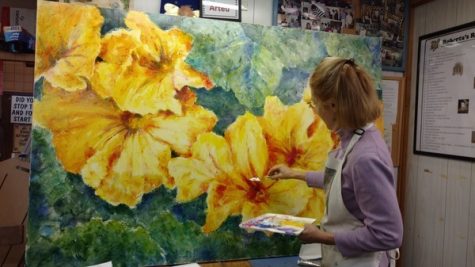Presentation promotes protection of bees
October 10, 2019
“The bees told me to,” Susan Curington said, clad in black and yellow, to the audience about why she chose to start her project “As the Bee Sees: a Pollinator’s Perspective.” The audience laughs, and she tells them she remembers the exact words they said to her. Everyone looks around in astonishment and in response she partially covers her mouth and goes “Buzzzzzzzzzzzzzz.”
If you’ve recently been in the Linfield Library, you may have seen Curington’s exhibit on the walls. Nine, four-foot by six-foot canvases, each displaying larger-than-life bunches of flowers from different fruits and vegetables. 
When you stand close to them, you become mesmerized by the almost translucent quality of the giant flora. Curington wanted to capture the bee’s point of view, hence the huge size. She recommends standing a foot or two away, and imagining that you’re a bee, staring into the mesmerizing petals, looking for some nectar for your queen.
So why did the bees tell her to paint for them? Because they are in trouble, and we are the only ones that can help.
About a third of the human food supply is dependent upon pollination services provided in large part by bees yet humans are indirectly responsible for the death of a least a third of their kind.
The flowers she chose to paint were carefully selected. Each one is the blossoms of crops most vulnerable to failure if bee populations become even more reduced. Aside from the human food shortages, a loss of bees would have devastating effects in natural ecosystems all over the world.
The audience was left wondering what they could do. Curington’s exhibit was a precursor to the talk that came later in the evening by Dr. Michael Breed.
Save the Bees: a Call to Action
Following Susan Curington’s presentation was a complementing lecture about how exactly to go about saving the bees. Delivered by Dr. Michael Breed, an ecology and evolutionary biology professor emeritus at the University of Colorado Boulder, the lecture was titled “Save the Bees: a Call to Action.”
There are over 25,000 species of bees all over the world, with several hundred wild species in the state of Oregon. Human activities are causing an unprecedented die-off in the United States of both the natural wild bee species and the non-native honey bee population.
Breed attributes their deaths to a few reasons. One of them is the loss of nesting habitat. On the projector screen he pulls up a photo of a concrete sidewalk and a lawn. He says it’s essentially the same as pouring concrete over the whole area, since bees can’t do anything with either of them.
The other reasons that bees are dying are pesticide use on their food and nesting grounds, and diseases and parasites brought by contact with other bee species.
Breed started off by highlighting the fact that bees may be something that we can save, much like how we revived the eagle population after they faced a similar population drop in the 1970s.
The three take-aways that Breed had for the audience to do their part in saving the bees were: “feed them, don’t poison them, and don’t disturb nesting habitat.”
To feed them, Breed suggests allowing the “weedy” plants to survive, such as dandelions and clovers. Bee gardens are a more interactive way of feeding bees.
“Plant some stuff,” he said. “And watch what bees are coming to and when you find out what in your yard bees are coming to, plant more of that!”
This point ties into his second take-away, “don’t poison them.” Applying herbicide to plants puts bee species at risk, because they ingest the poison and then bring it back to their hives and larvae.
His third take-away is don’t destroy nesting habitat. Bees nest in a variety of ways, not just in hives. Some, like the bumble bee, make burrows in abandoned rodent burrows. Others like hollowed-out pithy stems. He recommends leaving undisturbed dirt and natural areas alone, since bees nest almost everywhere.
Like their complementary speeches, both bee experts had a heartwarming message for their audience. “Choose one thing that pulls your heart strings,” said Susan Curington. Breed stressed that if we focus on one “wedge” of the issue at a time we will be able to help the Earth.
Susan Curington’s exhibit will be on display at the Nicholson Library until December 13. If you are interested in learning more about bees you can find more information here. If you want to learn more about saving bees, the Oregon Bee Project is a state organization with events and other ways to get involved.

Edgar Higgins • Oct 10, 2019 at 7:02 pm
Wow this is really good. I really like the layout of the paper, and it was well-written and informative. Most importantly, I was entertained! This makes me wanna save bees. Whoever wrote this has obviously been doing journalism for a long time because of how well it was written… keep it up!
alli • Oct 10, 2019 at 6:17 pm
it’s the bees knees yo
alli • Oct 10, 2019 at 6:15 pm
hey my sister write this.